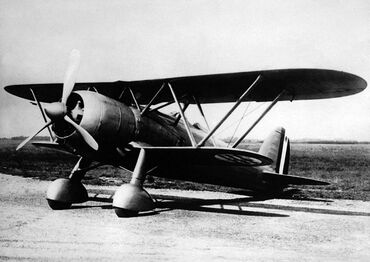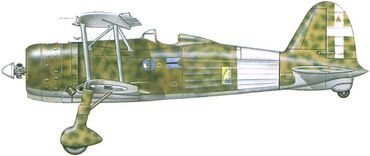The Fiat CR.42 'Falco' was a single-seat sesquiplane fighter which served primarily in Italy's Regia

Aeronautica before and during World War II. The aircraft was produced by the Turin firm, and entered service, in smaller numbers, with the air forces of Belgium, Sweden and Hungary. With more than 1,800 built, it was the most widely produced Italian aircraft to take part in World War II. The Fiat CR.42 was the last of the Fiat biplane fighters to enter front line service as a fighter, and represented the epitome of the type.
RAF Intelligence praised its exceptional manoeuvrability, further noting that "the plane was immensely strong", though it stood little chance against faster, more heavily armed monoplanes. It performed at its best with the Hungarian Air Force on the Eastern Front, where it had a kill to loss ratio of 12 to 1.
Design and development[]
The CR.42 was an evolutionary design based on the earlier Fiat CR.32, which was in turn derived from the Fiat CR.30 series created in 1932. The Regia Aeronautica had employed the CR.32 during the Spanish Civil War with great success, which led to Fiat proposing a more advanced fighter based around the supercharged Fiat A.74R1C.38 air-cooled radial engine geared to drive a metal three-blade Fiat-Hamilton Standard 3D.41-1 propeller of 2.9 metres (9 ft 6 in) diameter and a robust, clean, sesquiplane design. The rigidly braced wings covered with fabric were constructed from light duralumin alloy and steel. It reached a top speed of 438 km/h (272 mph) at 5,300 m (17,400 ft) and 342 km/h (213 mph) at ground level. Climb rate was 1 minute and 25 seconds to 1,000 m (3,280 ft) and of 7 minutes and 20 seconds to 6,000 m (19,700 ft).
In spite of the biplane configuration, the CR.42 was a modern, "sleek-looking" design based around a strong steel and alloy frame incorporating a NACA cowling housing the radial engine, with fairings for the fixed main landing gear. The CR.42's upper wing was larger than its low

er wing, a configuration known as a sesquiplane. The aircraft proved exceptionally agile thanks to its very low wing loading, although at the same time, the CR.42 lacked armour and radio equipment.
During evaluation, the CR.42 was tested against the Caproni Ca.165 biplane fighter, and was judged to be superior, although the Ca.165 was a more modern design which boasted a higher speed at the cost of maneuverability. Although the age of the biplane was coming to an end a number of other air forces expressed interest in the new fighter, and a number of early Falcos were delivered to foreign customers.
Soon after its combat introduction, Fiat developed a number of variants. The CR.42bis and CR.42ter had increased firepower, the CR.42N was a night fighter, the CR.42AS was optimised for ground attack, and the CR.42B Biposto was a two-seat trainer.
The Biposto was the most extensively modified, with a longer fuselage allowing a second seat to be placed in tandem. About 40 aircraft were produced by Agusta and Caproni Trento. Its length was increased by 68 centimeters over the standard fighter, to a total of to 8.94 m; the height was 23 centimeters less. Empty weight was only 40 kilograms (88 lb) more, as the wheel fairings had been removed. Overall weight was 2,300 kg. Top speed was 430 km/h at 5,300 meters, only 8 km/h less. Up to 1945, two machine guns were fitted.
Experimental configurations included the I.CR.42 and the CR.42DB. Beginning in 1938, Fiat had worked on the I.CR.42, then gave the task to complete the project to CMASA factory in Marina di Pisa on the Tirreno sea coast. The only prototype was built in 1940. Tests started at the beginning of 1941, at the Vigna di Valle base, on Lake Bracciano, north of Rome. Top speed was 423 km/h, range was 950 km while ceiling was reduced to 9,000 m. Empty weight went from 1,720 to 1,850 kilograms (3,790 to 4,080 lb), full weight from 2,295 to 2,425 kilograms (5,060 to 5,346 lb).
The CR.42DB was an attempt to improve the type's performance by installing a Daimler-Benz DB 601 V12 engine of 753 kW (1,010 hp). This prototype, MM 469), was flown by test pilot Valentino Cus in March 1941, over Guidonia Montecelio, near Rome. This variant could reach a top speed of 518 km/h (323 mph), with a maximum ceiling of 10,600 metres (34,777 ft) and a range of 1,250 kilometres (780 mi). The project was cancelled as the biplane configuration did not offer any advantages over contemporary monoplane fighter designs. Although it never went into production, to this day the variant has the distinction of being the fastest biplane ever flown.
It is still not certain how many CR.42s were built. The most likely estimate is 1,819 in total, including the 63 (51 according to some sources) produced under Luftwaffe control and the 140 produced for export.